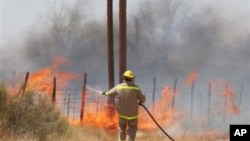Drought conditions and high winds have fueled destructive wildfires in northern Mexico and the southern U.S. plains states, especially Texas, where dozens of homes have burned in recent days. The dry weather is also having an impact on agriculture that is likely to cause some food prices to rise.
Fast-moving wildfires scorched around 32,000 hectares of land in the west Texas ranch country around Fort Davis on Saturday and Sunday, killing cattle and horses, and leaving pastures charred and smoky. The fires reached populated areas near Fort Davis, destroying 24 homes.
Fort Davis Volunteer Fire Department spokesman Jim Fowler says the people whose homes burned escaped unharmed and are in temporary lodging.
"The Red Cross Disaster Relief people are handling that effort. They are giving out hotel vouchers and food vouchers and a number of hotels here in town are offering free housing for those people," he said.
Fowler says some cows and horses were caught in the wildfires and were not able to escape. He says rescue teams patrolling the scorched rural terrain found animal remains in several places.
Fowler says high winds make it difficult for firefighters trying to contain the blazes and that the dry, windy conditions could last several more weeks.
"This time period, in the springtime, is traditionally when we have high winds and dry weather, so this is our normal fire season. The long-term forecasts we have looked at and the weather information we have researched indicate to us that we won't get much rain at all until our normal rains start in July and August," he said.
Texas State Climatologist and Texas A & M University Atmospheric Scientist John Nielsen-Gammon says the conditions that normally bring danger to far west Texas are now present in many other parts of the Lone Star State.
"March was the driest month on record for the state and springtime is when we get the strongest winds. So everything is coming together to make for extreme fire danger for Texas this year," he said.
Firefighters have gotten control of a wildfire that started this weekend near Midland, Texas, but not before it destroyed more than 30 homes and burned more than 6,000 hectares of ranch and farm land. The air quality along the U.S.-Mexico border was affected by smoke coming from a large wildfire in Mexico's northern state of Coahuila. As strong winds blow over much of Texas, fire departments and emergency management teams are keeping a close eye on areas where dry brush could fuel a blaze.
State Climatologist Nielsen-Gammon says the drought also is affecting some of the state's best agricultural areas.
"We are certainly not off to a good start. The conditions in east-central Texas, which right now are the hardest-hit drought areas, it is looking like the middle of summer already and so we missed spring entirely. It is going to depend a lot on how much rain falls in the next couple of months because May and June are typically among the wettest months of the year for the state," he said.
Nielsen-Gammon says much of the Texas wheat crop has already been damaged by the drought and that food prices are likely to rise. He notes that the average rainfall during the past five months in the state was only 12 centimeters, the least amount of rain since 1967. Texas is the largest producer of cattle in the United States and the second-largest grower of winter wheat.
Nielsen-Gammon says there is evidence that the droughts that periodically hit Texas coincide with changes in the water temperature in the Pacific Ocean off the coast of South America.
"Most of the droughts that we receive occur during a La Nina event, when equatorial Pacific Ocean temperatures are colder than normal, and that keeps the jet stream farther north and the storms away. But a lot of it is just the randomness of the weather and where the storm tracks end up setting up. Since the beginning of October, in fact, we have been getting one dry month after another," he said.
The Texas state climatologist says global warming might also play a role in that overall temperatures in the summer months in Texas have been trending higher during the past few decades.
The drought conditions are also causing problems for many other southern plains states including New Mexico, Colorado, Oklahoma as well as the Midwestern state of Kansas. Wheat prices on the Chicago futures market have risen by about 50 percent during the past year, partly because droughts in Australia and Russia have cut back global supply.
While drought conditions prevail in the U.S. southern plains, there has been too much rain in some areas further north. Experts say the flooding of fields in North Dakota and Canada, combined with drought damage in the south, could push prices even higher.







